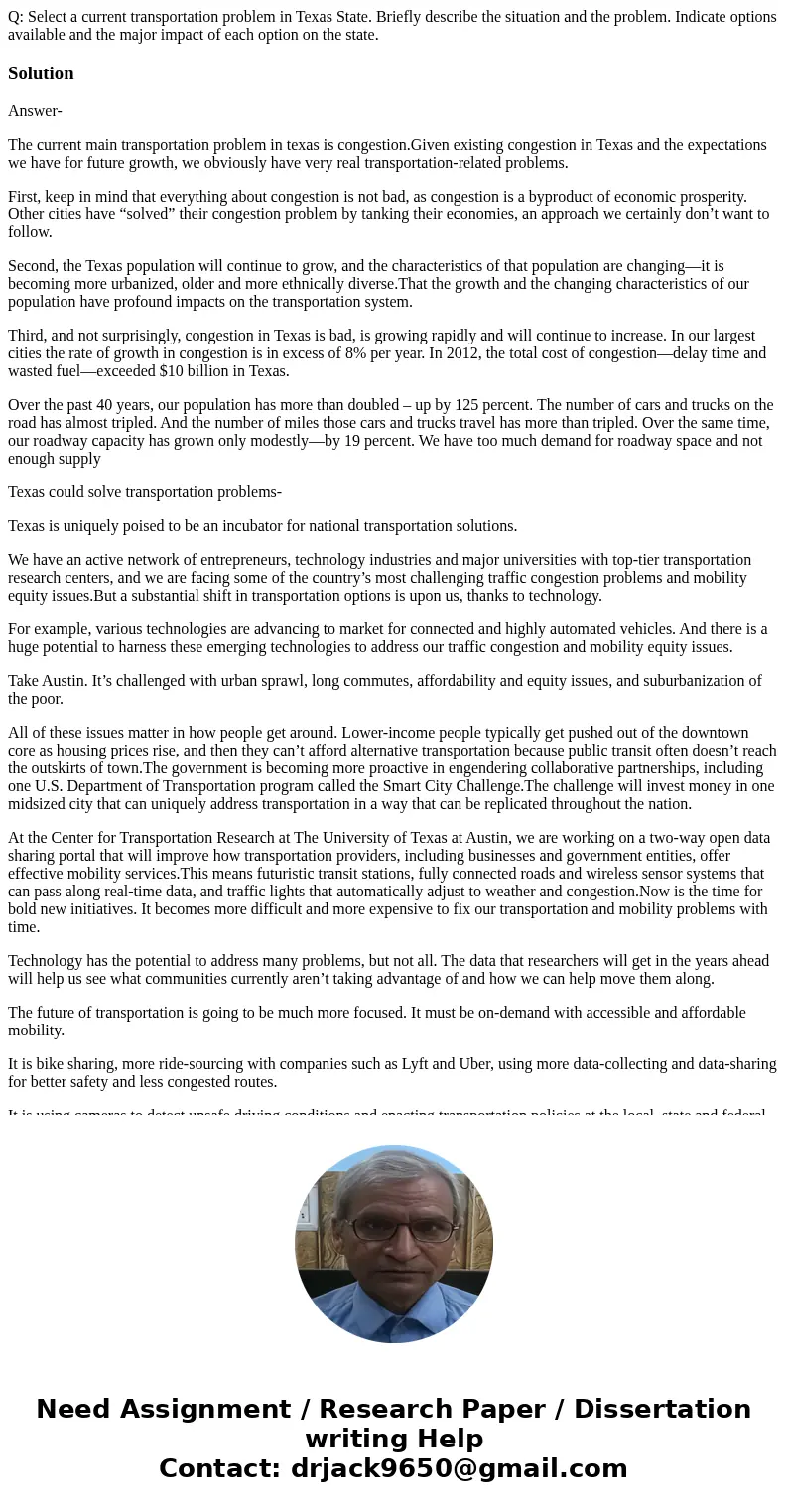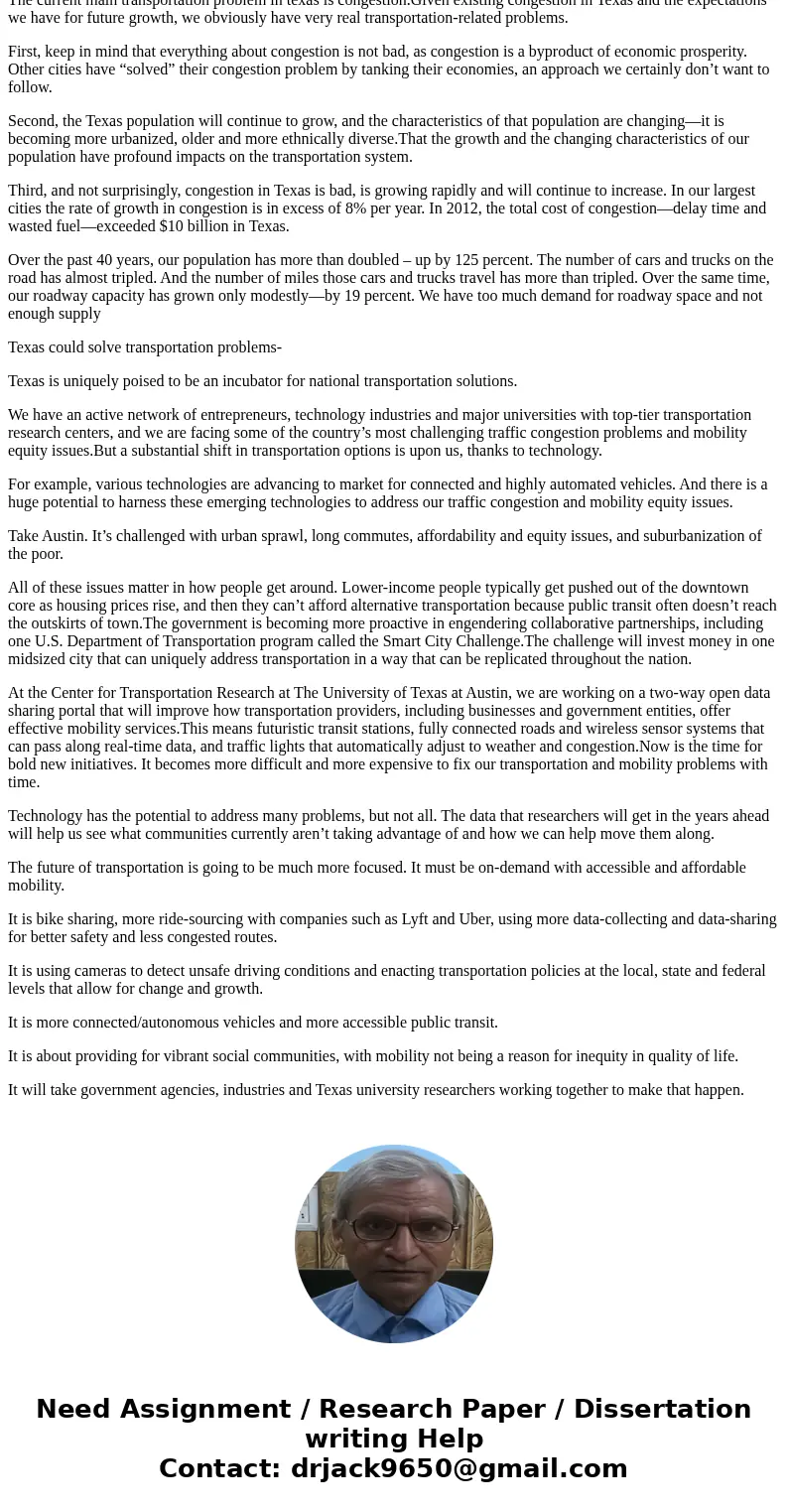Q Select a current transportation problem in Texas State Bri
Q: Select a current transportation problem in Texas State. Briefly describe the situation and the problem. Indicate options available and the major impact of each option on the state.
Solution
Answer-
The current main transportation problem in texas is congestion.Given existing congestion in Texas and the expectations we have for future growth, we obviously have very real transportation-related problems.
First, keep in mind that everything about congestion is not bad, as congestion is a byproduct of economic prosperity. Other cities have “solved” their congestion problem by tanking their economies, an approach we certainly don’t want to follow.
Second, the Texas population will continue to grow, and the characteristics of that population are changing—it is becoming more urbanized, older and more ethnically diverse.That the growth and the changing characteristics of our population have profound impacts on the transportation system.
Third, and not surprisingly, congestion in Texas is bad, is growing rapidly and will continue to increase. In our largest cities the rate of growth in congestion is in excess of 8% per year. In 2012, the total cost of congestion—delay time and wasted fuel—exceeded $10 billion in Texas.
Over the past 40 years, our population has more than doubled – up by 125 percent. The number of cars and trucks on the road has almost tripled. And the number of miles those cars and trucks travel has more than tripled. Over the same time, our roadway capacity has grown only modestly—by 19 percent. We have too much demand for roadway space and not enough supply
Texas could solve transportation problems-
Texas is uniquely poised to be an incubator for national transportation solutions.
We have an active network of entrepreneurs, technology industries and major universities with top-tier transportation research centers, and we are facing some of the country’s most challenging traffic congestion problems and mobility equity issues.But a substantial shift in transportation options is upon us, thanks to technology.
For example, various technologies are advancing to market for connected and highly automated vehicles. And there is a huge potential to harness these emerging technologies to address our traffic congestion and mobility equity issues.
Take Austin. It’s challenged with urban sprawl, long commutes, affordability and equity issues, and suburbanization of the poor.
All of these issues matter in how people get around. Lower-income people typically get pushed out of the downtown core as housing prices rise, and then they can’t afford alternative transportation because public transit often doesn’t reach the outskirts of town.The government is becoming more proactive in engendering collaborative partnerships, including one U.S. Department of Transportation program called the Smart City Challenge.The challenge will invest money in one midsized city that can uniquely address transportation in a way that can be replicated throughout the nation.
At the Center for Transportation Research at The University of Texas at Austin, we are working on a two-way open data sharing portal that will improve how transportation providers, including businesses and government entities, offer effective mobility services.This means futuristic transit stations, fully connected roads and wireless sensor systems that can pass along real-time data, and traffic lights that automatically adjust to weather and congestion.Now is the time for bold new initiatives. It becomes more difficult and more expensive to fix our transportation and mobility problems with time.
Technology has the potential to address many problems, but not all. The data that researchers will get in the years ahead will help us see what communities currently aren’t taking advantage of and how we can help move them along.
The future of transportation is going to be much more focused. It must be on-demand with accessible and affordable mobility.
It is bike sharing, more ride-sourcing with companies such as Lyft and Uber, using more data-collecting and data-sharing for better safety and less congested routes.
It is using cameras to detect unsafe driving conditions and enacting transportation policies at the local, state and federal levels that allow for change and growth.
It is more connected/autonomous vehicles and more accessible public transit.
It is about providing for vibrant social communities, with mobility not being a reason for inequity in quality of life.
It will take government agencies, industries and Texas university researchers working together to make that happen.


 Homework Sourse
Homework Sourse